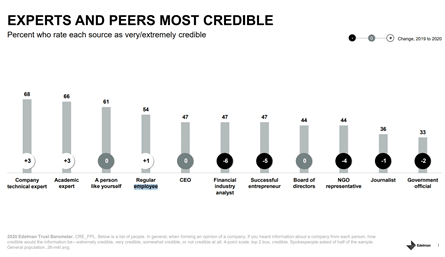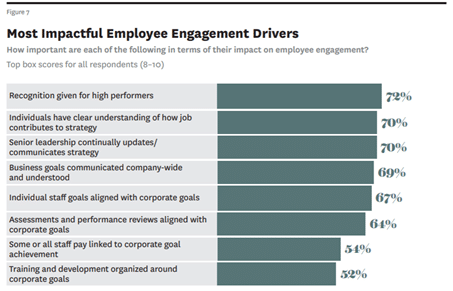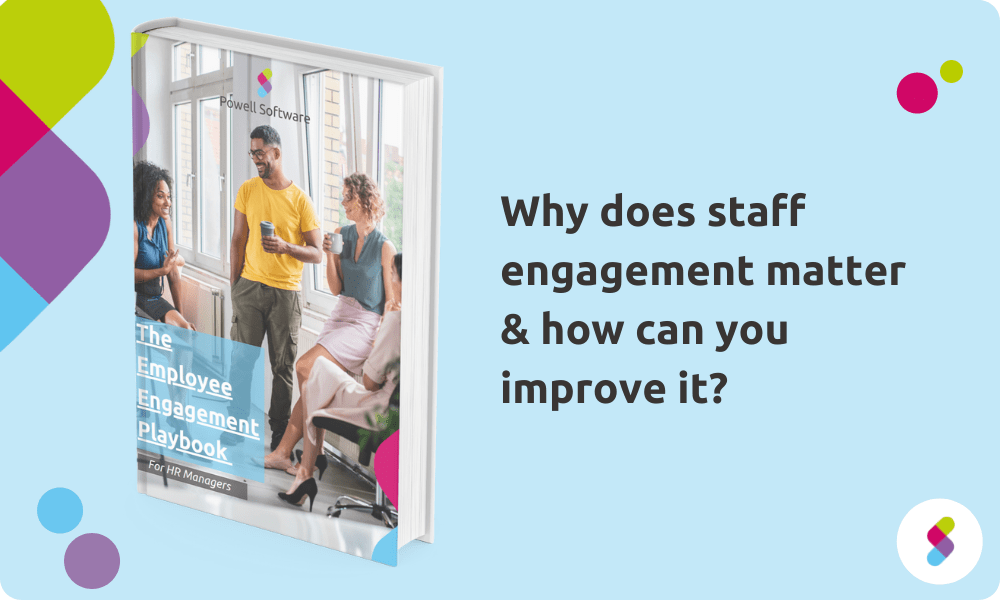What is employee engagement and why is it important?
Whether employees walk into an office or open a laptop each morning, ‘showing up’ is the easy part. Actually doing the work, and doing it well requires greater effort. The willingness of employees to do more than the bare minimum is linked to how engaged they are with the company.
Employee engagement can be defined as ‘’the emotional commitment the employee has to the organization and its goals’’ (Forbes). Low levels of engagement correspond with low morale and a general lack of enthusiasm. It’s logical that employers want to avoid this situation, most companies want employees to be happy in their roles.
In an ideal world, employees come to work every day optimistic and enthusiastic, ready to tackle their goals and targets head-on. They want to contribute to the success of the organization, increase revenue, and grow the success of the company. Yet, very few employees feel this way. In fact, a worrying 87% of employees are not engaged at work.
When your company doesn’t work towards improving employee engagement, you won’t reap the benefits of highly engaged employees, in fact, neglecting engagement can have a detrimental effect.
Download the Employee Engagement Playbook for HR Managers

When employees become disengaged everyone suffers but too few companies actively invest in the right employee engagement strategies to boost engagement. Many employers think setting high targets and piling on pressure is the only way to get employees to do their work. What these leaders miss is that creating this sort of atmosphere will only encourage employees to do what is required, but no more. It can also lead to long-term stress and burnout affecting employees’ mental and digital wellbeing.
Highly engaged employees, on the other hand, contribute more ‘discretionary effort’. These workers do more than is requested or expected because they want to. The extra tasks aren’t done out of fear, but a desire to help the company grow. Discretionary effort is invaluable to employers, bringing numerous benefits, but is only achieved in a culture where employees want to go the extra mile.
What are the benefits of highly engaged employees?
Here are just 5.
1. Higher productivity & profitability
Naturally, the increased discretionary effort output of engaged employees correlates with increased productivity. This results in companies with engaged employees seeing 17% higher productivity than their counterparts, and 21% higher profitability. These figures alone should be enough to make any executive take engagement strategies seriously. It’s a benefit worth investing in.

Employees who are engaged with the organization are more invested in the long term goals of the company. They see themselves staying indefinitely and believe that if they devote their efforts, they will be rewarded. For engaged employees, it makes sense to help achieve company goals as they see them as intrinsically linked to their own.
Disengaged employees fall into a different trap. They care less than other colleagues as they can’t see the future benefits that increased effort will bring for themselves. While they may still do their job, employers don’t benefit from any extra productivity.
2. Lower staff turnover
Employee engagement and retention are linked. Employees who are happily working towards the goals of the company, and see the benefit in doing so, are less likely to leave. The time and effort they give, along with the sense of achievement and connection they feel, build strong links to the company. These happy employees won’t be looking elsewhere, as their need for a sense of belonging and achievement are being fulfilled. Organizations with an engaged workforce, in turn, see 25% – 65% lower turnover.

Staff will always leave for new opportunities, it happens in every business but it’s costly. When large numbers of disengaged staff start leaving, it’s time for the organization to consider its strategies. Hiring new staff means firstly investing time and money in HR efforts. New hires then need to be trained and it can take 1 to 2 years before a new employee is ‘fully productive’. Employees need to learn about the company and its culture, find their way around and understand their role, it takes time before they are at their best.

The best way to avoid the cost of high staff turnover is to ensure that the current employees are engaged i.e. feel a sense of commitment to the organization.
3. Trusted brand advocates
It’s well known that people trust people, not organizations. 83% of respondents to a Nielsen survey said that friends and family are their most trusted source for recommendations. So, employees have an incredibly influential voice among their networks. What employees say can have more impact than senior leadership, 54% of people trust employees while only 47% trust the CEO of a company.
So when engaged employees share content with their network it is held in higher regard than that shared by a company. In fact, employees are the original ‘influencers’ that have become such a popular marketing strategy today.
However, employees will only share information and content they perceive as useful. When they associate their own name with the message they want to be sure it aligns with their beliefs. Highly engaged employees who are aligned to the goals of the organization will be quicker to share, as they naturally trust that what the organization creates is worthwhile. Disengaged employees won’t put the effort into sharing and will be skeptical of distributing the company’s messages.
Employee advocacy and engagement are intertwined. Building an effective employee advocacy program relies on engaged employees, but the right program can help boost engagement. It’s a win-win situation.
Interested in creating an employee advocacy program in your organization but don’t know where to start? We think you’ll find our employee advocacy templates very helpful.
4. Fewer mistakes
Highly engaged employees who pay close care and attention to their work are less likely to make mistakes. This is true for employees in every industry. Although mistakes are part of life, careless and avoidable mishaps are an expense organizations don’t want to incur.
A disengaged workforce can lead to a 60% increase in errors. The cost of the error depends on the persons’ role but could range from creating a faulty product to inputting the wrong financial figures. Serious errors can have a damaging impact on the reputation of the company as a whole.
Engaged workers take pride in what they do, and while they will still make the odd mistake they are more likely to try to spot and correct it or avoid making it again.
5. Better Team Morale
Culture is contagious, and when employees start to disconnect from the organization others soon follow. Identifying and remedying employee disengagement before it spreads too far is crucial.
Fostering a teamwork culture where people work together to achieve common goals is a great way to build engagement. The isolation that many are suffering while working remotely can be eased when the right tools are in place to facilitate collaboration. In turn employee engagement improves, with staff building emotional connections with each other and the company.
Leveraging highly engaged employees to stimulate teamwork will help build better morale, and ensure a culture of engagement is the one that spreads.
How can employee engagement be improved?
The benefits of engaged employees are clear as day, but less than a quarter of executives consider their employees ‘’highly engaged’’. It’s clear something is lost between the desire for engagement and achieving it, and it’s likely a lack of effective communication. A study by the Harvard Business Review explored the drivers of employee engagement, and over half relate to communication.
If engagement is defined as an ‘’emotional connection’’ to organization goals, the connection needs to be built through consistent and positive interactions and goals must be communicated. Employees can’t be expected to feel a sense of connection if they never hear from those leading the organization. The communication channel used to connect to employees then becomes critical. A top-down communication platform that allows leaders to get the same message to everybody often is needed. The corporate intranet could be an ideal solution. It acts as a central portal allowing management to share important announcements, strategy updates, and more.
Interested in learning more about employee engagement? We’ve put together a playbook for HR managers with strategies to boost engagement. We’ve also included these benefits of highly engaged employees so you have a comprehensive guide with all the information you need.


